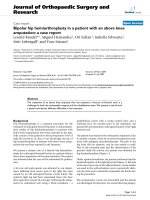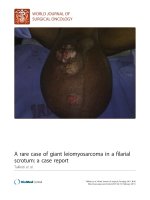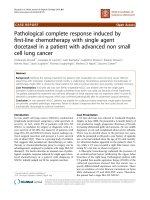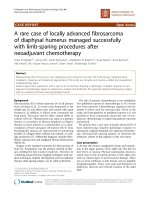A rare case of extremely high counts of circulating tumor cells detected in a patient with an oral squamous cell carcinoma
Bạn đang xem bản rút gọn của tài liệu. Xem và tải ngay bản đầy đủ của tài liệu tại đây (1.9 MB, 8 trang )
Wu et al. BMC Cancer (2016) 16:552
DOI 10.1186/s12885-016-2591-8
CASE REPORT
Open Access
A rare case of extremely high counts of
circulating tumor cells detected in a patient
with an oral squamous cell carcinoma
Xianglei Wu1,2,3, Romina Mastronicola2,4, Qian Tu1,2, Gilbert Charles Faure1,2,
Marcelo De Carvalho Bittencourt1,2*† and Gilles Dolivet2,4†
Abstract
Background: Despite aggressive regimens, the clinical outcome of head and neck squamous cell carcinoma
remains poor. The detection of circulating tumor cells could potentially improve the management of patients with
disseminated cancer, including diagnosis, treatment strategies, and surveillance. Currently, CellSearch® is the most
widely used and the only Food and Drug Administration-cleared system for circulating tumor cells detection in
patients with metastatic breast, colorectal, or prostate cancer. In most cases of head and neck squamous cell
carcinoma, only low counts of circulating tumor cells have been reported.
Case presentation: A 56-year-old white male with no particular medical history, was diagnosed with a squamous
cell carcinoma of oral cavity. According to the imaging results (computed tomography and 18F-fluorodeoxyglucose
positron emission tomography / computed tomography) and panendoscopy, the TNM staging was classified as
T4N2M0. A non-interruptive pelvimandibulectomy was conducted according to the multidisciplinary meeting
advices and the postoperative observations were normal. The patient complained of a painful cervical edema and a
trismus 6 weeks after the surgery. A relapse was found by computed tomography and the patient died two weeks
later. The search for circulating tumor cells in peripheral venous blood by using the CellSearch® system revealed a
very high count compared with published reports at three time points (pre-operative: 400; intra-operative: 150 and
post-operative day 7: 1400 circulating tumor cells). Of note, all detected circulating tumor cells were epidermal
growth factor receptor negative.
Conclusion: We report here for the first time a rare case of oral squamous cell carcinoma with extremely high
circulating tumor cells counts using the CellSearch® system. The absolute number of circulating tumor cells might
predict a particular phase of cancer development as well as a poor survival, potentially contributing to a
personalized healthcare.
Keywords: Oral squamous cell carcinoma, Circulating tumor cells, Head and neck squamous cell carcinoma,
Survival
* Correspondence:
†
Equal contributors
1
Laboratory of Immunology, Nancytomique platform, CHRU of Nancy, rue du
Morvan, 54500 Vandoeuvre-lès-Nancy, France
2
SBS Department, CRAN, UMR 7039 CNRS, University of Lorraine, Avenue de
la Forêt de Haye, 54500 Vandoeuvre-lès-Nancy, France
Full list of author information is available at the end of the article
© 2016 The Author(s). Open Access This article is distributed under the terms of the Creative Commons Attribution 4.0
International License ( which permits unrestricted use, distribution, and
reproduction in any medium, provided you give appropriate credit to the original author(s) and the source, provide a link to
the Creative Commons license, and indicate if changes were made. The Creative Commons Public Domain Dedication waiver
( applies to the data made available in this article, unless otherwise stated.
Wu et al. BMC Cancer (2016) 16:552
Background
Head and neck cancer, the sixth leading cancer by incidence worldwide [1], develops from the mucosal linings
of the upper aerodigestive tract. Approximately 95 % of
head and neck cancers have a squamous cell histological
aspect [2], also known as HNSCC (head and neck
squamous cell carcinoma). Despite aggressive treatment
regimens, many HNSCC patients (20–30 %) develop
locoregional recurrence (local recurrence / cervical lymph
node metastasis) or distant metastases. In addition, even
in cases where the resection margins were negative in
histopathological examination, there is still a risk of local
recurrence in 20 % of cases [3, 4]. Consequently, the fiveyear survival rate for all stages combined is 40–50 %. Of
note, human papillomavirus (HPV)-positive HNSCC
patients have a significantly better prognosis than HPVnegative patients, for instance lower disease specific mortality and recurrence rate [5].
Circulating tumor cells (CTC), which eventually detach
from the primary tumor and disseminate in the blood and
other body fluids, have been considered as a “liquid biopsy”
in the clinical assessment of cancer patients [6, 7]. The
diagnostic and prognostic values of CTC detection have
been established in some cancers, like breast, colorectal
and prostate cancers [8–10], but not yet in HNSCC. Recent
studies in HNSCC with small patient cohorts have shown
the potential clinical utility of CTC [11]. However, further
evidence is needed for evaluating comprehensively its application, such as unusual cases. Here, we report extremely
Fig. 1 Preoperative CT images. 1a axial plane; 1b coronal plane
Page 2 of 8
high enumerations of CTC detected in a patient with an
oral squamous carcinoma, which might also explain his
quick relapse and short survival.
Case presentation
A 56-year-old white male, former pipefitter, 68 kg
/169 cm, with no particular personal or familiar
medical-surgical history, presented with a lesion of oral
cavity of recent apparition. The cancer risk factors included unweaned smoking, valued at about 40 packyears, and alcohol consumption (weaned for 3 years).
Physical examination revealed an ulcerative lesion on
the right anterolateral floor of oral cavity, which was
adherent to the gingival fibro mucosa. Several leukoplakias were also observed on the gingival mucosa.
The rest of the otorhinolaryngology examination was
unremarkable.
A biopsy confirmed the lesion as an invasive well- /
moderately-differentiated squamous cell carcinoma. A
contrasted computer tomography (CT) scan showed a
tumoral process involving the muscles of the anterolateral floor of oral cavity, which extended about 3 cm in
the long axis and remained lateralized to the right
(Fig. 1). The lesion was in contact with the mandible
and furthermore developed a suspicious bone notch. No
cervical lymph nodes of significant size and no other
suspicious lesions on the cervical-thoracic level were
present in this CT scan. A 18F-fluorodeoxyglucose
positron emission tomography / computed tomography
Wu et al. BMC Cancer (2016) 16:552
(18F-FDG PET/CT) scan found a lesion of intense hypermetabolism next to the right genio-glosse triangular
muscles and lips, which seemed to repel the omohyoid
muscle without infiltrating it (Fig. 2). A lytic aspect of
the cortical bones of the mandible body suggested a
bone extension. 18F-FDG uptakes were perceptible in
lymph nodes of right groups Ib and II. The patient
received a panendoscopy under general anesthesia. The
upper gastrointestinal endoscopy and the bronchoscopy
did not find any abnormalities.
The TNM staging was classified as T4N2M0 (according to American Joint Committee on Cancer 2009) [12]
and noninterruptive pelvimandibulectomy was validated
as the primary treatment by a multidisciplinary meeting.
The surgery was performed in a satisfactory manner
2 months after the first consultation. The post-operative
care was performed by standard procedures without
abnormalities. The pathological analysis of excised specimens confirmed the squamous cell carcinoma histology
as well as the lymph node metastases (Fig. 3), suggesting
the definitive TNM stage as pT4aN2cM0. In addition,
the margins were negative but multiple tumor nodules
were found in the muscle. Immunohistochemical analysis
for HPV showed the staining of p40 but no expression of p16.
At the end of 6 weeks postoperative follow-up, the
patient complained of a painful cervical edema as well as
a trismus. A CT scan was ordered, which found regional
Fig. 2 Preoperative 18F-FDG PET/CT. 2a axial plane; 2b coronal plane
Page 3 of 8
multiple recurrences (Fig. 4). A multidisciplinary meeting
updated the treatment strategy including a surgical retake,
followed by radiochemotherapy. However, the patient died
2 weeks later due to cancer related complications.
Detection of CTC
The patient was recruited into a clinical research program
(VADS - EudraCT N°: 2010-A00586-33, approved by the
regional ethic committee “Comité de Protection des Personnes Est III”), which aimed to evaluate the prognostic
value of CTC in HNSCC. Venous blood samples were collected at three time points (preoperative day-1, intraoperative, and postoperative day 7) for the detection of CTC.
The manipulations were performed by using the CellSearch® system (Veridex LLC, Raritan, NJ) according to a
standard protocol [13]. The commercially available CellSearch® Tumor Phenotyping Reagent Epidermal Growth
Factor Receptor (EGFR) kit (Veridex LLC, Raritan, NJ,
USA) was used on the fourth channel of fluorescence of
the CellSearch® system following the manufacturer’s instructions. The pre-, intra-, and post-operative enumerations of CTC are shown in Fig. 5. A high count of CTC
was already detected at baseline (400 CTC), decreasing by
67.5 % at the intra-operative time point (150 CTC), after
which it increased significantly (1400 CTC). In particular,
all CTC were EGFR negative. Typical images of CTC are
shown in Fig. 6.
Wu et al. BMC Cancer (2016) 16:552
Page 4 of 8
Fig. 3 Fixed HE-stained pathology of excised tissue (original magnification 20×). The tissue corresponds to an infiltrative poorly-differentiated
squamous cell carcinoma. Arrow indicates an embolus in the vessel
Fig. 4 Postoperative CT images. 2a axial plane; 2b coronal plane
Wu et al. BMC Cancer (2016) 16:552
Page 5 of 8
Fig. 5 CTC enumeration per time point
Discussion
To our knowledge, this is the first report of extremely
high numbers of CTC in a case of squamous cell carcinoma of oral cavity. At present, the CellSearch® System is
the most commonly used and the only Food and Drug
Administration (FDA)-cleared CTC detection technique,
working on an EpCAM (Epithelial cell adhesion molecule) based-capture enrichment. Current published data
on CTC count using the CellSearch® System in HNSCC
patients reported a range of 0–5 CTC in 7.5 ml blood,
associated with the clinical features or survival [14–18].
In the case reported here, the initial CTC count was
already dozens of times higher than the known
published maximum. The CTC count achieved even several hundred numbers at post-operative day 7. Moreover,
as a label-dependent approach, the Cellsearch® might
have underestimated actual CTC load in circulation
owing to the possible existence of EpCAM negative
tumor cells.
Based on the fact that the absolute number of EpCAM
positive circulating epithelial cells was upregulated and
were negative for EGFR expression, one can hypothesize
that the CTC were probably in a particular phase associated with mesenchymal–epithelial transition (MET).
Since the samples were detected individually according
to the standard semi-automated procedure, we can
exclude the possibility of technical confounders, such as
contaminations. Besides, studies using the same method
in other malignancies, like breast [19], prostate [20],
colorectal [21], and gastrointestinal cancer [22] have
rarely found such high CTC counts. EGFR is overexpressed in over 90 % of HNSCC [23] but with a huge
discordance between the primary tumor and CTC.
Grisanti et al. [17] found that EGFR was expressed in
45 % of CTC from patients with recurrent or metastatic
HNSCC. In this work, no CTC was found to be EGFR
positive regardless of time point. Generally, MET is
thought as the reverse biological process of epithelialmesenchymal transition (EMT), but relatively poor
evidence has been found about its role in cancer when
compared to the extensive studies of the latter. Given
that MET induce upregulation of epithelial markers (E.g.
EpCAM) and that MET facilitates allowing cancerous
cells to regain epithelial properties, the absence of
EpCAM + EGFR + CTC vis-a-vis the enormous amount
of EpCAM + EGFR-CTC might suggest the development
of MET. Genetic studies revealed that mutations of the
EGFR gene family correlate with mRNA abundance and
protein level in patients with HNSCC [24, 25]. Thus, in
the case reported here, the lack of EGFR expression on
CTC could be also related to a rare mutated tumor type.
In addition, the higher count of CTC at the postoperative day 7 could be due to the re-entry of disseminative tumor cells in mesenchymal tissues into the
circulation [26].
The very short survival of this patient (disease-free survival, DFS and overall survival, OS) might be associated
with the high absolute number of CTC. Even if the patient
was diagnosed at stage IVA, the DFS of 1 month and the
OS of 2 months still indicate a rapid progression. The routine evaluation, TNM staging, seemingly could not provide a plausible prediction of this clinical outcome. Of
note, the presence of CTC has been reported to be an independent prognostic factor for predicting survival of
HNSCC patients with higher sensitivity at various disease
stages than routine staging procedures [17, 27, 28]. High
post-operative levels of CTC have also been reported to
accurately predict tumor recurrence [29]
Wu et al. BMC Cancer (2016) 16:552
Event Frame
34
4
66
5
93
6
218
11
466
18
645
24
867
32
956
35
1586
50
Page 6 of 8
Composite
CK PE
DAPI
CD45 APC
EGFR
Fig. 6 Representative CTC images from the CellSearch® system. Representative pre-operative CTC images of 7.5 ml blood from
the patient with an oral squamous cell carcinoma. DAPI, 4′, 6-diamidino-2-phenylindole; CK-PE, cytokeratin-phycoerythrin;
APC, allophycocyanin
Conclusion
In conclusion, this is the first report of a rare case of
extremely high CTC counts potentially associated with
the short survival in the oral squamous cell carcinoma
setting. The CTC detection constantly monitors the
tumor biology changes as a “liquid biopsy”. We believe
that such findings are of great significance in terms of
personalized healthcare, although might not be frequent.
Our data also might suggest a conceivable observation of
MET, which requires confirmation by additional specific
studies.
Abbreviations
18
F-FDG PET/CT, 18 F-fluorodeoxyglucose positron emission tomography
/ computed tomography; CT, computed tomography; CTC, circulating
tumor cells; DFS, disease-free survival; EGFR, epidermal growth factor
receptor; EMT, epithelial-mesenchymal transition; EpCAM, epithelial cell
adhesion molecule; FDA, food and drug administration; HNSCC, head
and neck squamous cell carcinoma; HPV, human papillomavirus; MET,
mesenchymal-epithelial transition; OS, overall survival; TNM, tumor nodes
metastasis
Acknowledgements
A special thanks to technicians of laboratory of Immunology for their
generous help.
Wu et al. BMC Cancer (2016) 16:552
Funding
This study has been supported by China Scholarship Council
(201508070022).
Availability of data and materials
All datasets on which the conclusions of the manuscript rely are presented
within this manuscript.
Authors’ contributions
XW and QT conducted the manipulations and data analysis; RM was
responsible for the clinical management; XW wrote the manuscript; RM,
GCF, MDCB and GD were in charge of the concept and design of the study;
MDCB and GD reviewed and edited the manuscript. All of the authors were
involved in revision of the manuscript and approved its final version.
Page 7 of 8
3.
4.
5.
6.
7.
8.
Competing interests
The authors declare that they have no competing interests.
9.
Consent for publication
The informed consent signed by the patient included an authorization to
publish the corresponding results and any accompanying images of this
Case report.
10.
Authors’ information
Xianglei Wu. Address: CHRU of Nancy, Laboratory of Immunology; rue du
Morvan, 54511 Vandoeuvre-lès-Nancy, France. Email:
Romina Mastronicola. Address: Institut de Cancérologie de Lorraine, Head
and Neck Surgery and Dental Units, Oncologic Surgery Department; 6
Avenue de Bourgogne, 54500 Vandœuvre-lès-Nancy, France. Email:
Qian Tu. Address: CHRU of Nancy, Laboratory of Immunology; rue du
Morvan, 54511 Vandoeuvre-lès-Nancy, France. Email:
Gilbert Charles Faure. Address: CHRU of Nancy, Laboratory of Immunology;
rue du Morvan, 54511 Vandoeuvre-lès-Nancy, France. Email: gilbert.faure@
univ-lorraine.fr
Marcelo De Carvalho Bittencourt. Address: CHRU of Nancy, Laboratory of
Immunology; rue du Morvan, 54511 Vandoeuvre-lès-Nancy, France. Email:
Gilles Dolivet. Address: Institut de Cancérologie de Lorraine, Head and Neck
Surgery and Dental Units, Oncologic Surgery Department; 6 Avenue de
Bourgogne, 54500 Vandœuvre-lès-Nancy, France. Email:
Declarations
This study (VADS - EudraCT N°: 2010–107 A00586-33) has been approved by
the regional ethic committee “Comité de Protection des Personnes Est III”. A
signed informed consent was obtained from the patient at his inclusion in
the study (before any treatment). A copy of this written consent is available
for review by the Editor of this journal.
11.
12.
13.
14.
15.
16.
17.
18.
Author details
1
Laboratory of Immunology, Nancytomique platform, CHRU of Nancy, rue du
Morvan, 54500 Vandoeuvre-lès-Nancy, France. 2SBS Department, CRAN, UMR
7039 CNRS, University of Lorraine, Avenue de la Forêt de Haye, 54500
Vandoeuvre-lès-Nancy, France. 3Department of Otorhinolaryngology - Head
and Neck surgery, Zhongnan Hospital of Wuhan University, No. 169 Donghu
Road, 430071 Wuhan, China. 4Head and Neck Surgery and Dental Units,
Oncologic Surgery Department, Institut de Cancérologie de Lorraine, 6
Avenue de Bourgogne, 54500 Vandœuvre-lès-Nancy, France.
Received: 14 October 2015 Accepted: 20 July 2016
19.
20.
21.
22.
References
1. Siegel RL, Miller KD, Jemal A. Cancer statistics, 2015. CA Cancer J Clin.
2015;65(1):5–29.
2. Chaturvedi AK, Anderson WF, Lortet-Tieulent J, Curado MP, Ferlay J,
Franceschi S, Rosenberg PS, Bray F, Gillison ML. Worldwide trends in
incidence rates for oral cavity and oropharyngeal cancers. J Clin Oncol.
2013;31(36):4550–9.
23.
Looser KG, Shah JP, Strong EW. The significance of “positive” margins in
surgically resected epidermoid carcinomas. Head Neck Surg. 1978;1(2):107–11.
Spiro RH, Guillamondegui Jr O, Paulino AF, Huvos AG. Pattern of invasion
and margin assessment in patients with oral tongue cancer. Head Neck.
1999;21(5):408–13.
O’Rorkea MA, Ellisonb MV, Murraya LJ, Moranc M, Jamesc J, Anderson LA.
Human papillomavirus related head and neck cancer survival: a systematic
review and meta-analysis. Oral Oncol. 2012;48(12):1191–201.
Alix-Panabieres C, Pantel K. Circulating tumor cells: liquid biopsy of cancer.
Clin Chem. 2013;59(1):110–8.
Schmidt H, Kulasinghe A, Perry C, Nelson C, Punyadeera C. A liquid biopsy
for head and neck cancers. Expert Rev Mol Diagn. 2016;16(2):165–72.
Cohen SJ, Punt CJ, Iannotti N, Saidman BH, Sabbath KD, Gabrail NY, Picus J,
Morse M, Mitchell E, Miller MC, et al. Relationship of circulating tumor cells
to tumor response, progression-free survival, and overall survival in patients
with metastatic colorectal cancer. J Clin Oncol. 2008;26(19):3213–21.
Cristofanilli M, Hayes DF, Budd GT, Ellis MJ, Stopeck A, Reuben JM, Doyle GV,
Matera J, Allard WJ, Miller MC, et al. Circulating tumor cells: a novel
prognostic factor for newly diagnosed metastatic breast cancer. J Clin
Oncol. 2005;23(7):1420–30.
Danila DC, Heller G, Gignac GA, Gonzalez-Espinoza R, Anand A, Tanaka E,
Lilja H, Schwartz L, Larson S, Fleisher M, et al. Circulating tumor cell number
and prognosis in progressive castration-resistant prostate cancer. Clin
Cancer Res. 2007;13(23):7053–8.
Kulasinghe A, Perry C, Jovanovic L, Nelson C, Punyadeera C. Circulating
tumour cells in metastatic head and neck cancers. Int J Cancer. 2015;
136(11):2515–23.
Edge SB, Compton CC. The American Joint Committee on Cancer: the 7th
edition of the AJCC cancer staging manual and the future of TNM. Ann
Surg Oncol. 2010;17(6):1471–4.
Janssen Diagnostics L. CELLSEARCH® Circulating Tumor Cell Epithelial Kit
(IVD) IFU No. e631600001-V 2013-08. 2013.
Nichols AC, Lowes LE, Szeto CC, Basmaji J, Dhaliwal S, Chapeskie C,
Todorovic B, Read N, Venkatesan V, Hammond A, et al. Detection of
circulating tumor cells in advanced head and neck cancer using the Cell
Search system. Head Neck. 2012;34(10):1440–4.
Bozec A, Ilie M, Dassonville O, Long E, Poissonnet G, Santini J, Chamorey E,
Ettaiche M, Chauviere D, Peyrade F, et al. Significance of circulating tumor
cell detection using the Cell Search system in patients with locally
advanced head and neck squamous cell carcinoma. Eur Arch
Otorhinolaryngol. 2013;270(10):2745–9.
Grobe A, Blessmann M, Hanken H, Friedrich RE, Schon G, Wikner J,
Effenberger KE, Kluwe L, Heiland M, Pantel K, et al. Prognostic relevance of
circulating tumor cells in blood and disseminated tumor cells in bone
marrow of patients with squamous cell carcinoma of the oral cavity.
Clin Cancer Res. 2014;20(2):425–33.
Grisanti S, Almici C, Consoli F, Buglione M, Verardi R, Bolzoni-Villaret A,
Bianchetti A, Ciccarese C, Mangoni M, Ferrari L, et al. Circulating tumor cells
in patients with recurrent or metastatic head and neck carcinoma:
prognostic and predictive significance. PLoS One. 2014;9(8):e103918.
Buglione M, Grisanti S, Almici C, Mangoni M, Polli C, Consoli F, Verardi R,
Costa L, Paiar F, Pasinetti N, et al. Circulating tumour cells in locally
advanced head and neck cancer: preliminary report about their possible
role in predicting response to non-surgical treatment and survival. Eur J
Cancer. 2012;48(16):3019–26.
Zhang L, Riethdorf S, Wu G, Wang T, Yang K, Peng G, Liu J, Pantel K.
Meta-analysis of the prognostic value of circulating tumor cells in breast
cancer. Clin Cancer Res. 2012;18(20):5701–10.
Moreno JG, O’Hara SM, Gross S, Doyle G, Fritsche H, Gomella LG, Terstappen
LW. Changes in circulating carcinoma cells in patients with metastatic
prostate cancer correlate with disease status. Urology. 2001;58(3):386–92.
Negin BP, Cohen SJ. Circulating tumor cells in colorectal cancer: past,
present, and future challenges. Curr Treat Options Oncol. 2010;11(1–2):1–13.
Hiraiwa K, Takeuchi H, Hasegawa H, Saikawa Y, Suda K, Ando T, Kumagai K,
Irino T, Yoshikawa T, Matsuda S, et al. Clinical significance of circulating
tumor cells in blood from patients with gastrointestinal cancers. Ann Surg
Oncol. 2008;15(11):3092–100.
Rubin Grandis J, Melhem MF, Gooding WE, Day R, Holst VA, Wagener MM,
Drenning SD, Tweardy DJ. Levels of TGF-alpha and EGFR protein in head
and neck squamous cell carcinoma and patient survival. J Natl Cancer Inst.
1998;90(11):824–32.









